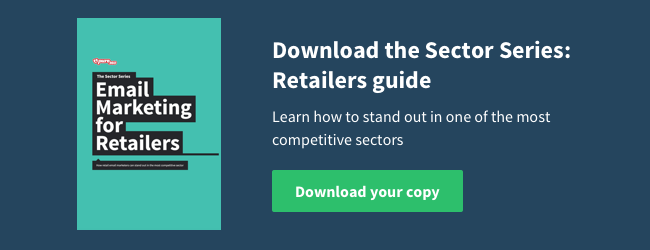It’s safe to say that marketers are convinced of the power of personalisation. Most agree it makes for more relevant shopping experiences, increases conversion and nurtures customer loyalty.
But what about when personalisation goes wrong? When you searched for a one-off gift and now you’re being targeted with similar products? Or pursued with emails about buying something you were casually researching and have long-since dismissed?
To help you avoid these irritating errors, we take a look at what checks and balances you can put in place to make sure you stay on the right side of the customer when using personalisation.
Ask for data
You’re not likely to find me in a pair of wellies, pruning roses or digging-up my own veg but according to Amazon I’m some kind of budding Alan Titchmarsh. The problem is they’ve mistaken my gift buying behaviour for a genuine personal interest and ever since I’ve been targeted with content and emails about gardening. What Amazon failed to do (yes, shock horror – the kings of personalisation sometimes still get it wrong) is ask me whether my purchase was for me or someone else. If they’d bothered to ask and then use the information they wouldn’t waste their time targeting me with content that only meets a need once a year when I’m buying birthday gifts.
If you’re using behavioural targeting technology such as PureTargeting to present a personalise storefront, recommendations or targeted email content, then make sure the information you present is something the person browsing has consistently shown an interest in. If you notice that some purchases fall outside what would be expected from their normal behaviour take care to exclude it from any personalisation you have in place. Use customer insight technology such as PureIntelligence to sense check your customer’s behaviour against trends and established patterns. And by simply asking your customers whether they’re buying for themselves or someone else during the checkout process you’ll make sure you keep your content relevant.
Gather feedback
I shop on ASOS a lot – just ask my bank or partner about my online fashion addiction. But despite my loyalty there are some brands on ASOS which I wouldn’t be seen dead in. But regardless of my taste in fashion, I’m still being shown them when I search for items.
Getting the balance right can be tricky for the online retailer – shoppers still want to be presented with their favourites but also want to be inspired or even surprised. It often leaves retailers hesitant to restrict their product catalogues too much, especially when when fashions change so quickly.
Online retailer Zalando overcome this conundrum by simply asking their browsers for feedback such as ‘Want to see more like this?’ or ‘Don’t like this brand? When the customer responds it enriches their data and their ability to display the best content for each individual by using machine learning to refine the search results. And by giving feedback the customer knows they’re helping themselves to find what they want more easily, which makes for a win-win situation with far less scrolling, abandoned searches and a more fulfilling shopping experience.
Set limits
I rue the day I casually looked at a flight from Southampton to Manchester – I was just curious, not serious. It was during a time of frustration with the dysfunction of Southern Rail and I wanted to see if I could justify an increase in my carbon footprint, but I soon felt guilty and begrudgingly booked the train. But TripAdvisor are like a dog with a bone – sending me emails about flights to Manchester five months after making the initial search and three month since I returned from the trip. Just five days ago they sent me all the prices for flights on this route right-up until August. I’m on the point of cracking, revising my annual summer holiday and booking a mini break to Lancashire just to stop them emailing me about it!
If you’re sending abandonment emails then it’s important to set a limit or change tack if you don’t get the response you want after a few communications. By sending the same messages again and again you’ll irritate customers, become irrelevant and start being ignored. By all means send an email soon after an abandonment, a gentle reminder or promotion to sway them, but stop emailing them about a very specific product or service if you fail to get a response. There’s a reason they’re not responding!
Look at research on sales cycles for guidance for how long it takes a person to consider their purchase and don’t continue to pester them once you think they’re unlikely to buy – it does more damage than good.
If you follow these principles you’ll make sure you target your customers appropriately with personalisation.
Remember to always monitor your metrics to make sure your marketing is hitting the mark – your open rates, length of browsing sessions, abandonment, engagement and click-through and conversion rates will guide you on how your marketing is being received. Use behavioural targeting and customer insight technology such as PureIntelligence and PureTargeting to identify the trends and patterns in your customer’s behaviour to target them with the most relevant and timely communications.
Rant over – I’m off to buy a gift for a 90 year old, look at bridesmaid dresses and book my trip to Cardiff – goodness knows what I’ll receive in return…

